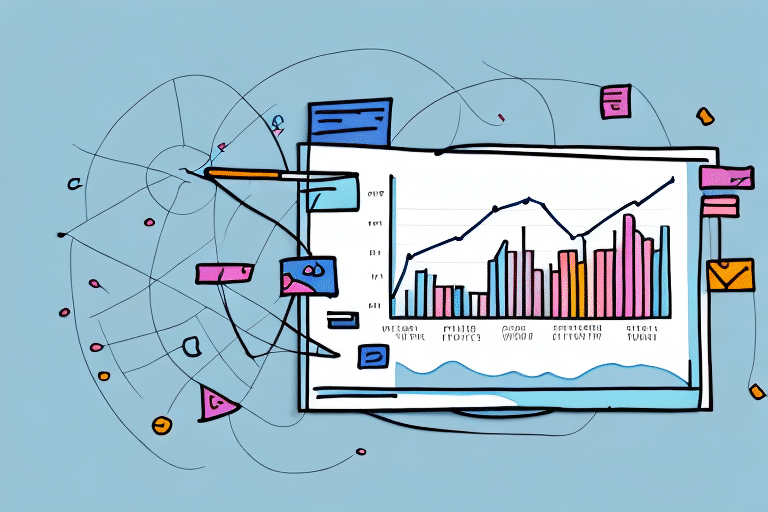Creating a Customer Retention Chart: A Step-by-Step Guide
In today's competitive business landscape, customer retention is critical for sustainable growth and success. Retaining existing customers costs far less than acquiring new ones. Additionally, loyal customers tend to spend more and refer others to your business, making it essential to effectively measure and track customer retention.
Why Customer Retention is Critical for Your Business Success
Customer retention is vital because it helps maintain a steady revenue stream. Acquiring new customers requires significant effort and resources, and converting prospects into loyal customers isn't always straightforward. With numerous alternatives available, customers can easily switch to competitors offering better deals. Thus, it's crucial to keep existing customers happy, engaged, and satisfied with your products or services.
Moreover, customer retention leads to increased profitability. Loyal customers are more likely to make repeat purchases and spend more over time. They also tend to recommend your business to friends and family, enhancing your customer base through word-of-mouth marketing. According to a Harvard Business Review study, increasing customer retention by 5% can boost profits by 25% to 95%. Additionally, a strong retention rate helps build a reputable brand and differentiate your business in a crowded marketplace.
Understanding the Basics of Customer Retention
Customer retention refers to a business's ability to keep its customers over a specific period. Key metrics used to measure customer retention include:
- Customer Churn Rate: The percentage of customers who stop doing business with you during a given period.
- Repeat Purchase Rate: The percentage of customers who make more than one purchase in a specific period.
- Customer Lifetime Value (CLV): The total revenue a business can expect from a single customer account throughout the business relationship.
Tracking these metrics helps identify patterns and trends in customer behavior, understand what drives loyalty, and implement strategies to improve retention rates.
Achieving high levels of customer retention requires a strategic approach, including personalized marketing campaigns, improved customer service, loyalty programs, and regular engagement through social media and other channels.
Key Metrics to Track for Customer Retention
To create an effective customer retention chart, identify the key metrics most relevant to your business:
- Churn Rate: The percentage of customers who stop using your service or product within a given timeframe.
- Retention Rate: The percentage of customers who continue to do business with you over a specific period.
- Repeat Purchase Rate: The percentage of customers who make multiple purchases over a certain period.
- Customer Lifetime Value (CLV): The projected revenue a customer will generate during their relationship with your business.
Additional metrics include:
- Net Promoter Score (NPS): Measures how likely customers are to recommend your business to others. Learn more about NPS.
- Customer Effort Score (CES): Evaluates how easy it is for customers to interact with your business. Understand CES.
Metrics may vary based on industry and business goals. For instance, subscription-based services might track monthly recurring revenue (MRR) and churn by subscription plan. Identifying the most relevant metrics allows for data-driven decisions that enhance customer retention and drive growth.
How to Identify Your Loyal Customers
Identifying loyal customers is crucial for effective retention strategies. Loyal customers are more likely to stick with your business long-term and advocate for your brand. Common methods to identify loyal customers include:
- Repeat Customers: Those who have made multiple purchases.
- High Spenders: Customers who spend significantly on your products or services.
- Advocates: Customers who refer others or provide positive reviews.
Additionally, analyzing customer engagement can help identify loyalty. Customers who interact regularly with your social media, attend events, or participate in loyalty programs show strong brand investment. Tracking responses to marketing campaigns, such as email open rates and ad clicks, can also indicate potential loyalty.
The Importance of Customer Feedback in Retention
Understanding customer perceptions of your products or services is essential for improving retention. Regularly soliciting customer feedback helps identify areas needing improvement and ensures retention strategies align with customer needs.
Customer feedback also assists in recognizing loyal customers, allowing you to reward their loyalty. Acknowledging their input strengthens relationships and enhances loyalty, leading to positive word-of-mouth marketing. Tools like SurveyMonkey and Qualtrics can facilitate effective feedback collection.
Crafting a Retention Strategy that Works for Your Business
Developing an effective retention strategy involves careful planning, testing, and optimization tailored to your business's unique needs, target audience, and industry. Key components include:
- Define Retention Goals: Clearly outline your retention objectives.
- Identify Customer Segments: Understand different customer groups and their needs.
- Select Retention Tactics: Choose appropriate strategies and channels for engagement.
- Budget and Timeline: Allocate resources and set timelines for implementation.
Understanding why customers leave is crucial. Conducting surveys, analyzing feedback, and monitoring behavior can uncover root causes of churn. Addressing these issues with targeted tactics, such as improving customer service or enhancing product features, can significantly improve retention.
Ongoing measurement and analysis are essential. Regularly tracking metrics like CLV, churn rate, and repeat purchase rate helps identify improvement areas and optimize retention tactics. Continuous testing and refinement ensure your strategy remains effective and relevant.
Tools and Resources for Creating a Customer Retention Chart
Creating a customer retention chart requires specific tools and resources, including:
- CRM Software: Tools like Salesforce or HubSpot CRM help track customer interactions and gather valuable data.
- A/B Testing Tools: Platforms such as Optimizely enable testing different retention strategies to identify the most effective ones.
- Survey Tools: Tools like SurveyMonkey and Qualtrics help gather customer feedback and measure satisfaction.
- Data Visualization Tools: Platforms such as Tableau or Microsoft Power BI assist in creating visually appealing charts and graphs to communicate retention metrics.
Analyzing Your Data and Making Informed Decisions
Creating a customer retention chart is just the first step. Analyzing the data collected helps identify patterns and trends in customer behavior, assess the effectiveness of retention strategies, and make informed decisions to enhance retention rates.
Use data analysis to pinpoint areas needing improvement, such as customer service or product features. Implement changes based on insights and measure their impact to ensure continuous improvement in retention efforts.
Common Mistakes to Avoid When Designing a Retention Chart
When designing a retention chart, avoid the following common mistakes:
- Undefined Goals: Failing to set clear retention goals and objectives.
- Irrelevant or Inaccurate Data: Using data that doesn't accurately reflect customer behavior or is not relevant to retention.
- Lack of Segmentation: Not segmenting customers or targeting the wrong audience.
- Ignoring Strategy Testing: Not testing retention strategies or assuming past successes will continue.
- Data Neglect: Failing to analyze data or make informed decisions based on insights.
Case Studies: Successful Examples of Customer Retention Charts
Learning from successful case studies can provide valuable insights into effective retention strategies. Notable examples include:
- Amazon: Utilizes retention charts to detect patterns in customer behavior, enabling personalized recommendations and improving retention rates.
- Netflix: Employs retention charts to measure customer engagement with content and predict churn rates, allowing proactive retention efforts.
- Zappos: Tracks customer satisfaction levels through retention charts, enhancing customer service and retention rates.
Tips to Ensure Long-Term Success with Your Retention Chart
To ensure long-term success with your retention chart, consider the following tips:
- Continuous Monitoring: Regularly track and analyze retention metrics to stay updated on customer behavior.
- Test Different Strategies: Experiment with various retention tactics to identify what works best for your business.
- Respond to Feedback: Address customer feedback promptly to show that you value their opinions.
- Personalize Experiences: Offer tailored experiences and rewards to loyal customers to enhance their satisfaction.
- Integrate with Marketing: Align your retention efforts with overall marketing strategies to create a cohesive customer experience.
Continuously Improving Your Chart Through Testing and Iteration
Creating an effective retention chart is an ongoing process that requires continuous testing and iteration. As customer behavior evolves, adjust your retention strategies and tactics accordingly. Regularly test new approaches, analyze their effectiveness, and refine your chart to identify new opportunities for growth and improvement.
Integrating Your Chart with Other Marketing Efforts
Integrating your retention chart with other marketing efforts enhances the overall customer experience. Align retention strategies with your broader marketing objectives to ensure consistency in brand values, messaging, and positioning. This holistic approach ensures that retention efforts complement other marketing initiatives, leading to a unified and effective customer engagement strategy.
Measuring the ROI of Your Customer Retention Chart
To measure the return on investment (ROI) of your customer retention chart, track the impact of retention efforts on key business metrics such as revenue, profit, customer acquisition costs, and customer lifetime value. Calculating ROI helps demonstrate the value of retention initiatives to stakeholders and guides data-driven decisions for future retention strategies.
For example, if a retention strategy leads to a 10% increase in CLV, the resulting profit growth can be directly attributed to the initiative, showcasing its effectiveness and justifying further investment.
Conclusion
Creating a customer retention chart is essential for any business aiming to retain customers and drive sustainable growth. By following this step-by-step guide, you can develop a retention chart that aligns with your business goals, targets your audience effectively, and measures the success of your retention efforts. Continuously monitor and analyze retention metrics, experiment with different strategies, and integrate retention efforts with other marketing initiatives to create a comprehensive customer experience. These actions will help increase customer loyalty, enhance satisfaction, and achieve long-term business success.




















